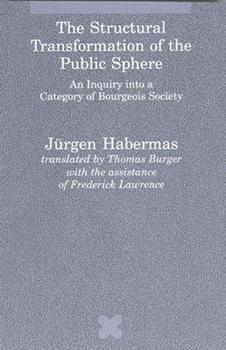The Structural Transformation of the Public Sphere: An Inquiry Into a Category of Bourgeois Society
Select Format
Select Condition 
Book Overview
This is J rgen Habermas's most concrete historical-sociological book and one of the key contributions to political thought in the postwar period. It will be a revelation to those who have known Habermas only through his theoretical writing to find his later interests in problems of legitimation and communication foreshadowed in this lucid study of the origins, nature, and evolution of public opinion in democratic societies.
Format:Paperback
Language:English
ISBN:0262581086
ISBN13:9780262581080
Release Date:August 1991
Publisher:MIT Press
Length:326 Pages
Weight:1.06 lbs.
Dimensions:0.7" x 5.9" x 9.0"
Age Range:18 years and up
Grade Range:Postsecondary and higher
Customer Reviews
2 ratings
One of the most influential studies on the subject
Published by Thriftbooks.com User , 20 years ago
Habermas' work, though written more than four decades ago, still retains most of its original relevance for the study of the public sphere. If you are interested in this subject, and if you are into critical thinking, then this book is certainly worth reading. Why? Well, if you take in consideration the fact that no other book has been written so far on the subject that has been able to surpass Habermas' account both in depth and originality, then you begin to get my point. As to a critical reading of the argument put forth by Habermas, one should read "Habermas and the Public Sphere", edited by Craig Calhoun. This book includes an appendix by Habermas where he revises some of his original positions.
The Structural Transformation of the Public Sphere
Published by Thriftbooks.com User , 23 years ago
When you talk about the public sphere in front of intellectuals, Jürgen Habermas's name is bound to come up. Habermas's 1962 study, "The Structural Transformation of the Public Sphere," examines the creation, brief flourishing, and demise of a public sphere based in rational-critical debate and discussion. The feasibility of a true public sphere, which is inclusive of anyone who would participate, is for Habermas of utmost importance. Habermas follows a methodology similar to the one Michel Foucault takes in "Discipline and Punish," which analyzes the abolition of public displays of power, and the process by which the structures of power are inculcated in the individual from the 17th through the 20th centuries. Habermas analyzes historical, economic, and political conditions from classical antiquity through his own historical moment, tracing the circumstances in which the public sphere arises, how it functions, and ceases to function over time. Habermas begins with a delineation of the terms 'public' and 'private,' orienting them philologically from their roots and meanings in classical antiquity. From here, he traces the adoption of the words and their synonyms into the European Middle Ages and the era of feudalism. Habermas says that in this period, the feudal lord and the monarch, for whom `representative publicness' functioned as a display of power before their subjects, dominated the public. Authority figures embodied virtues and powers in a public fashion. Public representation of political and economic power continued, unabated until the Reformation, at which time, the privatization of religious faith signaled a separation between society and the state. Economically, in the 16th and 17th centuries, the spread of trade necessitated the spread of news from various locales. As news outside of the home became relevant to home economy, the private individual begins to take an interest in public events. Consolidation of 'national' financial administration and state-controlled taxation, along with the rise of print culture, facilitated the dissemination of news, initially in the form of governmental decrees, market conditions, and happenings at court. Through this, the actions of the authorities came under the scrutiny of a reading public. The 18th century is the key moment for Habermas. In this period, the government, along with private individuals, made use of the press, for the first time, in persuasive appeal to a public made up of private people. The press now presented the public with information, with which they were to use reason and discussion to determine what was in the public's interest. Habermas emphasizes the theoretical parity that this brings about - the rise of the coffee houses and salons, in which merchants met with gentility and engaged in rational-critical debate over issues of public import. Stretching this into the realm of the franchise, Habermas is careful to point out the problematics of a situation in which actual decis






